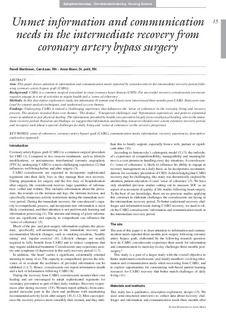Unmet information and communication needs in the intermediate recovery from coronary artery bypass surgery
Journal article, Peer reviewed
Permanent lenke
http://hdl.handle.net/11250/134278Utgivelsesdato
2010Metadata
Vis full innførselSamlinger
Originalversjon
Martinsen, R. & Moen, A. (2010) Unmet information and communication needs in the intermediate recovery from coronary artery bypass surger. Vård I Norden. 30(4) s.15-19.Sammendrag
Coronary artery bypass graft (CABG) is a common surgical procedure
for CHD (1). Compared to less invasive treatments, such as lifestyle
modifications, or percutaneous transluminal coronary angioplasty
(PTCA), undergoing CABG is a more challenging experience (2) that
influences well-being before and after surgery (3).
CABG convalescents are expected to incorporate sophisticated
regiments into their daily lives as they manage their own recovery.
During preparation for surgery and the few days of hospitalization
after surgery, the convalescent receives large quantities of information:
verbal and written. This includes information about the procedure,
the wounds on the sternum and legs, the sternum incision, and
specifically, temporary activity restrictions during the immediate recovery
period. During the immediate recovery, the convalescent’s capacity
to comprehend, process, and incorporate new information is most
likely constrained, and their attention is not paid towards learning and
information processing (4). The amount and timing of given information
are significant, and capacity to comprehend can influence the
‘sense of coherence’ (5).
Much of the pre- and post-surgery information explains the procedure,
specifically self-monitoring in the immediate recovery and
recommended lifestyle changes, such as smoking cessation, ‘healthy
eating’ and ‘regular exercise’ (6). Lifestyle changes are usually
required to fully benefit from CABG and to reduce symptoms that
may require additional treatment. Convalescents may experience anxiety
and symptoms of depression in this early recovery period (1,7).
In addition, ‘the heart’ carries a significant, existentially oriented
meaning to many of us. The capacity to comprehend; process the relevance
of or evaluate the usefulness of provided information can be
inhibited (1,4,7). Hence, convalescents can report information dearth
and a lack of information following CABG (8).
During the recovery from CABG, convalescents monitor their own
healing and are encouraged to adopt sophisticated regiments for
secondary prevention as part of their daily routines. Recovery experiences
alter during recovery (3,9). Women report setbacks from unexpected
muscular pain in the chest and problems with maintaining
recommended activity levels after surgery (10,11,12). Men can experience
the recovery process more smoothly than women, and they attribute
this to family support, especially from a wife, partner or significant
other (10).
According to Antonovsky’s salutogenic model (5,13), the individual’s
experience of comprehensibility, manageability and meaningfulness
is a core premise to handling every day situations. A convalescent’s
‘sense of coherence’ is likely to influence his ability to engage in
recovery management on a daily basis, as he incorporates recommendations
for secondary prevention of CHD. Acknowledging that CABG
recovery may be challenging, this study was theoretically inspired by
attention, patient education (4) and ‘sense of coherence’ (5). We have
only identified previous studies setting out to measure SOC as an
aspect of assessment of quality of life studies following heart surgery.
To the best of our knowledge, there are no previous studies applying
this construct to elaborate challenges the convalescents are facing in
the intermediate recovery period. To better understand recovery challenges
and information needs during CABG recovery, we need to elicit
the CABG convalescents’ information and communication needs in
the intermediate recovery period.
Beskrivelse
The original publication is available at: http://www.artikel.nu/Bob/GetBob.aspx?bobID=3312
